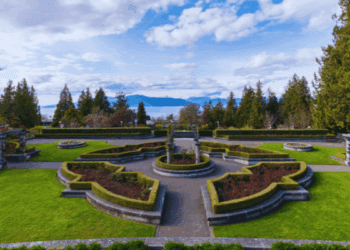If the First World War marked Canada’s emergence as a more independent nation, the Second World War showcased its ability to exceed expectations on the global stage. Canadian fighter aces and air crews defended the UK during the Blitz, while our sailors and merchant navy helped turn the tide in the Battle of the Atlantic. Canadian troops drove the Nazis from Italy, stormed Juno beach during D-Day, and slogged through muddy, flooded fields to liberate the Netherlands. By V-E Day – Victory in Europe – our allies saw us as equals.
But that was eight decades ago. Today, as authoritarian regimes challenge Western democracies, the echoes of past conflicts resonate. Decades of neglect have left Canada’s military a shadow of its former self. This special three-part series delves into Canada’s pivotal role in the V-E Day victory and examines the current state of our armed forces, offering insights on how Canada can reclaim its stature in national security and defence. Parts 1 and 2 set the scene, while Part 3 brings the conflict into focus for Canadians today.
Part 2: Valour and sacrifice – Canada’s pivotal role in securing the V-E Day victory
By J.L. Granatstein, May 1, 2025

Source: Public domain.
In the early morning of August 19, 1942. some 5,000 Canadian troops waded through the calm coastal waters and onto the hard pebble beaches at Dieppe, France. Little did they know, they were rushing headlong towards disaster.
The Germans controlled the heights that dominated the landing beaches, with well-trained troops in place that managed to check the advance of the Canadian infantry and armour.. Correspondent Ross Munro landed and saw the dead in the sea and along the shore: “It was brutal and terrible and shocked you almost to insensibility.” The German defenders killed more than 900 Canadians and captured 1,947 more. Only around 2,000 Canadian soldiers, mostly those who had yet to get ashore, managed to return to England. It was a debacle, an exercise in poor British and Canadian planning explained away after the fact by saying that lessons had been learned – unfortunately, the hard way.
Among those left on the beach was Private James Molloy from Niagara Falls, Ontario. Hit by shrapnel, the Royal Hamilton Light Infantry soldier was patched up in a hospital, and then shipped east to a prisoner of war camp near Leipzig, Germany. The Germans put Molloy to work in a salt mine, a horrid task that would be his lot for the next two-and-a-half years. Canadian Red Cross parcels helped to keep him and his mates alive. The care packages each weighed 126 ounces, and contained milk powder, corned beef, salmon, jam, cheese, sugar, coffee, chocolate and other essentials. Most important, the parcels let the POWs know they were not forgotten.
***
The fall of Hong Kong in 1941 and the demoralizing defeat at Dieppe, forced Canada and the allies to regroup.
Meanwhile, at sea, the Royal Canadian Navy grew quickly, eventually reaching 75,000 men and women by the end of 1943 and 100,000 by war’s end. Tasked with escorting convoys to Britain – a gruelling mission that meant fighting Nazi submarines that sometimes fought in “wolf packs” and sunk merchant ships with their torpedoes – the Canadians fought from their corvettes, many built in Canadian shipyards. Small, and lightly armed with a gun, an anti-aircraft weapon, and depth charges, the agile corvette sometimes struggled for stability in the rough North Atlantic. Winter storms often coated it in ice that had to be chipped off.

Source: US Navy/Public domain.
The commanders and crews learned on the job, but it was a long, hard process. One senior officer recalled that “A corvette would come up the river from some building yard like Sorel, the crew having been shipped a week before… In some cases, they didn’t know how to light the boiler fires… We had those ships three or four days,” he went on, “and they were sent out into the Atlantic Ocean.” In Spring 1942 enemy subs began to operate in the Gulf of St. Lawrence, and RCN ships had to be diverted to push them out.
The U-boats kept winning into 1943, but then in the late spring the battle swung in favour of the Allies. More air cover, frigates that were better than corvettes, stronger radars, new Asdic (or sonar), bigger, more powerful depth charges that could be flung ahead of the corvette by “hedgehog” devices, and experience all helped. On some ships, the new radar had to be installed in the officers’ washrooms, the only available space.
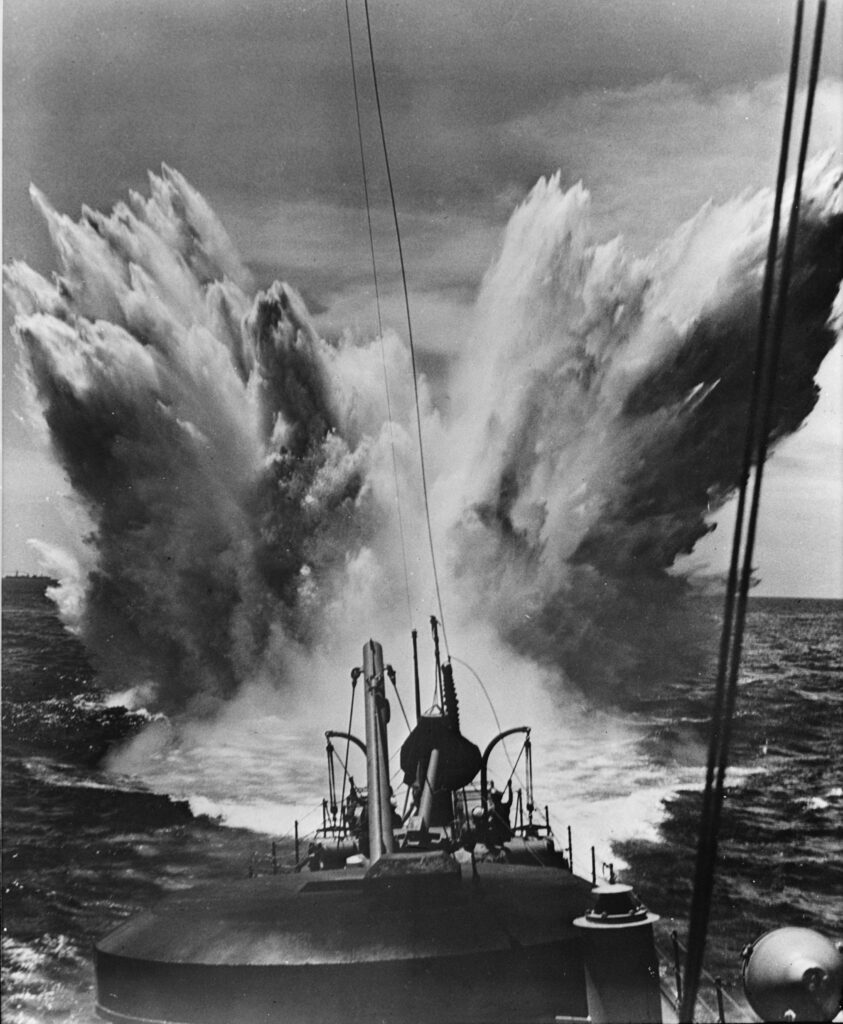
Slowly, the Battle of the Atlantic tilted in the Allies’ favour (the RCN ended up destroying 33 U-boats) forcing the Germans to pull back, though the U-boat threat did not finally end until V-E Day. Increasing numbers of convoys, formed in New York and Halifax, safely made it to Britain, carrying the soldiers, equipment, munitions, and food that kept Britain in the war and the growing Canadian and American armies fed and equipped. In all, the RCN escorted half the convoys across to Britain, 160 million tonnes of cargo in their holds. But the merchantmen paid a heavy price: 67 Canadian vessels sunk with 13 per cent of Canada’s 12,000 merchant sailors lost; 3,500 Allied ships went down, drowning more than 70,000 men. The RCN lost 31 warships and just over 2,000 men.
***
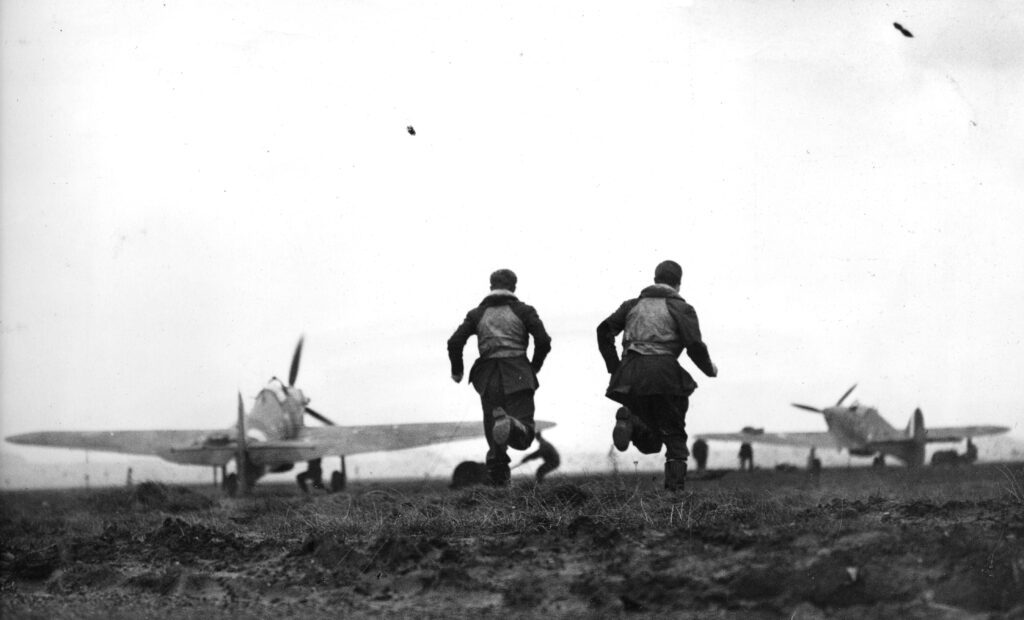
Source: Public domain.
Like the Navy, the Royal Canadian Air Force experienced dramatic growth, reaching a strength of 250,000 who served. One RCAF fighter squadron fought in the Battle of Britain in 1940, and by the middle of 1941, Canada had five fighter squadrons in Britain, mainly carrying out raids on Nazi targets in France. In August 1942, RCAF and RAF fighters fought over Dieppe, trying to cover the troops on the beaches; they suffered heavy losses, most of those shot down landing on French soil where they fell into German hands. Hundreds more pilots flew with RAF fighter, bomber, or transport squadrons, serving everywhere the British fought – in North Africa, India, Ceylon, Burma, and Malta. Indeed, one RCAF pilot, George “Buzz” Beurling from Verdun, Quebec, had 27 “kills” during his time in Malta, making him the most notable Canadian airman of the war.
The RCAF also played a major role in the RAF’s Bomber Command. From one bomber squadron in 1941, eight in 1943 and 14 at its peak, the RCAF’s No. 6 Bomber Group with some 300 aircraft wreaked havoc on German targets. Bombing was the Allies’ only way of striking Germany for the first three years of the war, and its initial effects were limited. But technology, bigger and better aircraft, and improved training and discipline multiplied the effects dramatically. Thousands of bomber raids began to level cities and factories, “de-housing” workers and disrupting production. One airman noted that “Bomber Command dished out the dirt when no else on our side could.” Another, however, worried that “the thought of what we are doing sometimes appals me.” Most, however, simply did their job, overcoming their fear to fly in the face of enemy interceptors, “ack-ack” guns, searchlights, and sudden death.
By the summer of 1943, Canadian bomber crews engaged in massive raids, all but destroying Hamburg. More raids followed, one after another. Hitler’s government had to react, and it moved more of its fighter aircraft from Russia, North Africa, and Italy to protect the Reich and pulled thousands of 88mm anti-aircraft guns back from the front. The RAF’s Bomber Command suffered 55,573 killed out of a total of 125,000 aircrew (a 44.4 per cent death rate), while a further 8,403 were wounded in action and 9,838 became prisoners of war. The RCAF lost 9,880 officers and men killed on Bomber Command service, a terrible toll; the total Air Force dead, many in training accidents, numbered 17,001.
***
After years of training, the Canadian Army finally got its taste of sustained action in 1943. On July 10, 1943, the First Canadian Infantry Division and the 1st Canadian Armoured Brigade Landed on the Sicilian coast. The British and Americans had cleared German Forces from North Africa, and aimed to liberate Sicily next.
The landings went well, with lighter opposition than they had feared. Unfortunately, the winding, steep hills of Sicily made for perfect defensive terrain, and once the Canadians came up against German soldiers, the fighting turned serious. On July 17, two brigades attacked Valguarnera and took the town after a stiff fight. The cost: 145 killed and wounded. The Canadians were relatively inexperienced, but learned quickly.
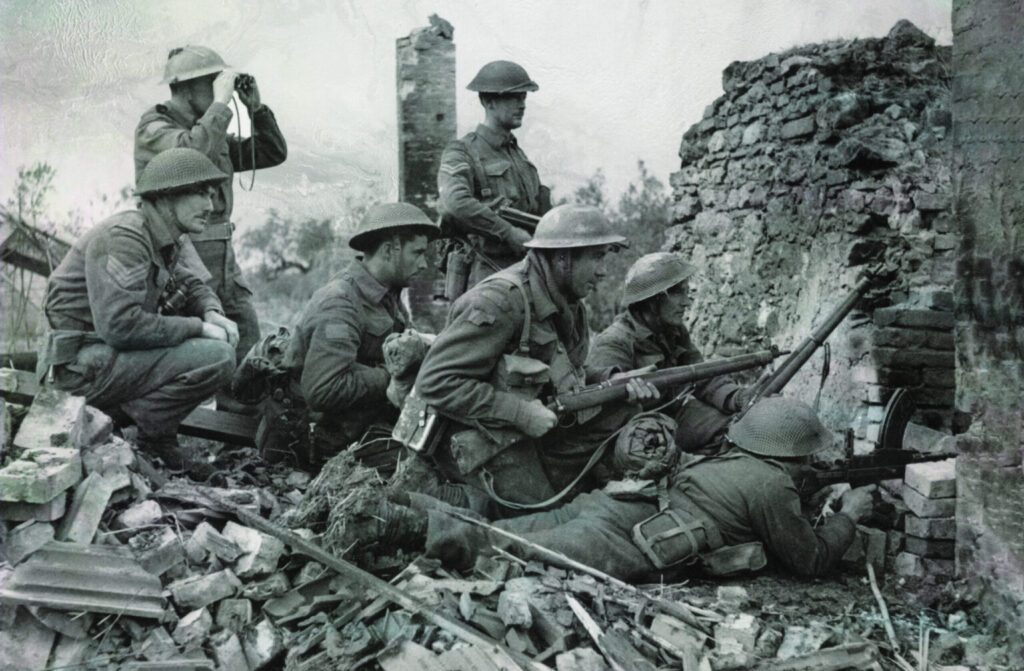
Source: Public domain.
During the 38-day Sicily campaign Canada suffered 562 killed, 1664 wounded, and 84 captured. The Canadians next turned their attention to the mainland, landing on the toe of the Italian boot on September 3. The Germans attempted to slow the allies’ advance, but by October, the Canadians had pushed then back almost 500 kilometres. Finally, the German resistance began to stiffen. As Nazi and Canadian forces clashed, the Germans rushed to complete a defensive line on the Moro River and at the town of Ortona on the Adriatic coast.
The fighting at the Moro was vicious, with the Canadians crossing the river only to be pushed back. Author Farley Mowat, then a young officer in the Hastings and Prince Edward Regiment, wrote that “We were appalled by the ferocity of the German reaction” and “realized we had never before seen war in its full and dreadful magnitude.” CBC correspondent Matthew Halton called the fighting “little Passchendaeles of mud and blood.” After heavy casualties, the First Division crossed the Moro and captured the river’s northern bank.
Next up was Ortona – today known as Canada’s “little Stalingrad.” Defended by German paratroopers, every inch was contested, every building fought for, with soldiers “mouse-holing” through walls from one house to the next. “If it wasn’t hell,” the CBC’s Halton reported, “it was the courtyard of hell, a maelstrom of noise and hot spitting steel.” Finally on December 27, the German paratroopers pulled out of the destroyed city. Liberating the area from the Moro River to the northern edge of Ortona had cost Canada 2,339 killed, wounded, and missing. Sickness rates had increased four-fold, and battle exhaustion numbers added another 1,617. The First Division had won the battle but, as its commander noted, it was no longer effective and needed time to recuperate.
Meanwhile the Fifth Canadian Armoured Division and the I Canadian Corps headquarters established itself in Italy. The new formations, along with the experienced ones, would have their first major battles in May 1944 on the western side of Italy, facing the Gustav and Hitler Lines. They did well, cracking the Gustav Line at heavy cost, one platoon of the 48th Highlanders taking a key hill after Lieutenant N.A. Ballard subdued a German officer with his fists. Ballard won the Distinguished Service Order, a rare distinction for a junior officer and second only to a Victoria Cross. The fighting at the fixed defences of the Hitler Line was even worse, with one officer noting that the enemy firing was “more intense than anything” his unit had known. The Germans reduced the exhausted Canadian units to company strength. But the infantry punched a hole through the line and the tanks followed, winning the battle.
Even so, the Canadians’ British superiors in the 8th Army criticized them, alleging bad staff work and poor traffic management. Some of this was fair, but Canada was merely following the British plan. Still, the Allies made progress, and liberated Rome between June 4 and 6, just as Allied troops were storming the beaches of Normandy.
The next major action for I Canadian Corps came at the end of August on the Adriatic end of the Germans’ Gothic Line defending Rimini and the Po valley. Breaching the Gothic Line was arguably the greatest Canadian feat of the entire war. In all 92,757 Canadians had served in Italy; 5,399 had been killed, just under 20,000 wounded, and almost 1,000 captured. The casualties were almost 30 per cent. “Sunny Italy” had been a killing ground.
***
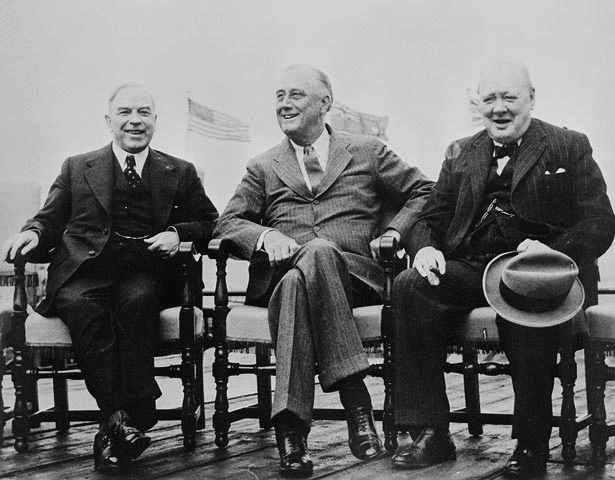
As the First Canadian Army fought in Italy, the other half – II Canadian Corps, made up of the Second and Third Canadian Infantry Divisions and the Fourth Canadian Armoured Division, the 2nd Armoured Brigade and the 1st Parachute Battalion – trained for the invasion of France. This involved many exercises, strenuous physical training, and the acquisition of new Sherman tanks. By the beginning of June 1944, all was ready for D-Day.
Leading up to attack, the Allied forces had pummelled French road and rail networks from the air, and the navies, including destroyers and minesweepers from the RCN, had worked to contain or destroy the enemy’s U-boats and surface vessels. This had been enormously successful: the Allies managed to greatly reduce the Luftwaffe strength in France, and largely pen in the German navy. Unfortunately, efforts to smash Wehrmacht bunkers and strong points on the five landing beaches proved largely ineffectual.

Source: Library and Archives Canada/Public domain.
On June 6, 1944, the Allies launched the world’s largest amphibious assault. As the 1st Parachute Battalion seized a key bridge over the River Orne, the 7th and 8th Brigades of the Third Division assaulted Juno Beach, one of the five landing beaches, and Sergeant-Major Charlie Martin of the Queen’s Own Rifles shouted to his men as they left their landing craft at Bernieres-sur-Mer, “Move! Fast! Don’t stop for anything.” But the Germans were ready: “That first rush,” Martin said, “racing across the beach, scaling the wall, crossing the open railway line that ran parallel to the beach, all under heavy MG fire claimed a lot of us in the first minute or two.” It was the same on every part of Juno Beach – and the four other beaches – but the soldiers pressed forward supported by cannon fire from amphibious Shermans that had made it to land and gunfire from the ships just offshore. By dark on June 6, the Allies had put 150,000 men ashore and the Canadians were digging in well inland. Their casualties – 340 killed and 570 wounded – were terrible enough but a far fewer toll than the planners had feared.
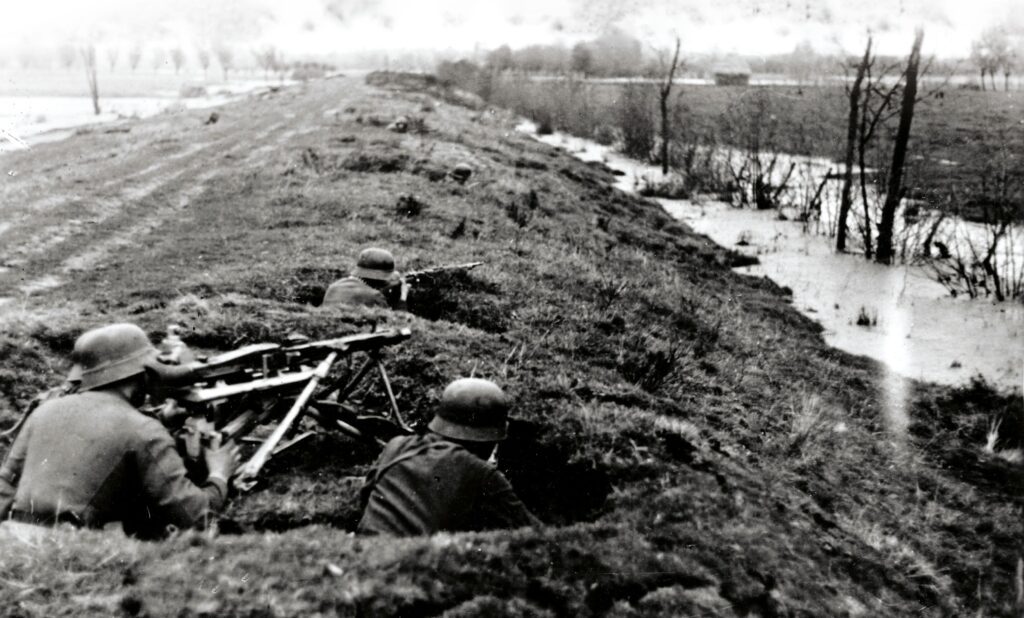
For the next two months, the fighting seemed stalemated. The Germans moved in Panzer and SS divisions that fought tenaciously, slowing the Allies and inflicting losses on them as heavy as during the worst fighting of the Great War. The Allies eventually captured Caen, largely destroyed by bombing, in July, but its heavily defended industrial plants on the outskirts remained.
The 3rd Division had carried the load until the 2nd and 4th Divisions arrived, bring II Corps and First Canadian Army up to full strength. In charge were Lieutenant-Generals Harry Crerar and Guy Simonds. Simonds as the Corps commander was innovative, brusque, and demanding. On August 8, he launched a massive attack, Operation Totalize, south toward Falaise, a region of northern France marked by rolling countryside, open fields, and small villages, making substantial gains though hampered by an errant bombing by American aircraft. The friendly fire disaster gravely wounded staff officer Captain Brian Dickson, who woke up in a field hospital where triage had put him with the men who were beyond saving. But a surgeon from his hometown of Winnipeg saw him and took him into the operating room and, though he lost a leg, saved his life. Dickson became the Chief Justice of the Supreme Court, saved by a chance encounter with a friend.
A second assault, Operation Tractable, aiming to press further south to close the gap between advancing US units and the Canadians finally succeeded, though not before being bombed and machine-gunned by RAF and RCAF aircraft. As the fighting went on, the dead lay everywhere. Major Gerald Levenston, a staff officer at Simonds’ headquarters, wrote home to say that “one of my jobs is to provide working parties to bury the dead… the unbelievable horror of it all.” Two hundred thousand Germans tried desperately to escape the cauldron and many managed to scrape through before the Allies sealed the gap on August 21, leaving behind some 50,000 dead, more wounded, and mountains of equipment. More than 5,000 Canadians died in the fighting in Normandy.
The Allies drove the Nazis from Paris on August 25, and hope rose that the war might be over by Christmas. It was not to be, and the Canadians in October found themselves fighting on the dykes and in the canals of Belgium and the Netherlands, trying to clear the Scheldt River estuary to open the way to Antwerp for shipping carrying desperately needed supplies for the Allied armies. The Canadians fought in miserable conditions, with one soldier reminiscing years later, “we were wet, always wet, always cold.” The enemy resisted fiercely, and again, the Canadians suffered heavy casualties – especially when flooding forced them to fight in waist-deep water, or in the open along narrow causeways. As one platoon officer described it, the Canadians “were indescribably dirty… wet from living in water-filled holes in the ground… they were exhausted.”
Despite the odds, the Canadians emerged victorious. Clearing the Scheldt had cost Canada more than 5,000 dead – but Allied shipping finally had a safe route into Amsterdam by late November 28.
* * *
As Canadian casualties rose, complaints about infantry shortages eventually reached the politicians in Ottawa.
By early November, 1944, Canada found itself plunged into a new conscription crisis. Prime Minister King quickly found himself at odds with his Defence Minister, Colonel J.L. Ralston. As senior officers leaked complaints to the media, calls arose to send “home defence” conscripts to the front lines. King fired Ralston, but that did nothing to alleviate the pressure on the government, and in mid-November the Prime Minister reversed course and ordered 16,000 conscripts overseas.
The move saved Mackenzie King’s government, but angered Quebec, which largely saw World War II as a European conflict. It also frustrated many others across the country who believed the Prime Minister had reneged on his earlier pledge. In the end, few of the conscripts reached the front, and the crisis dissolved. The home front somehow held together through the greatest political crisis of the war.
The Canadian Army, meanwhile, largely rested in December 1944 and January 1945 as the I Canadian Corps travelled from Italy to Northwest Europe, arriving in February and early March.
Fighting resumed on February 8,1945 with Operation Veritable. The First Canadian Army led a force of thirteen divisions with a strength of 470,000 including British, American, Polish, Belgian, and Dutch troops. The target was Germany’s Rhineland, defended behind well constructed fortifications. They battled in miserable weather. The cold and wet troops, the Regina Rifles war diary noted, “are suffering from exhaustion due to continual shelling and the nature of the woods.” Near Goch, Germany, the commander of the Royal Hamilton Light Infantry later called it “the most vicious battle I remember.” But the Canadians pressed on through the forested Hochwald and reached the Rhine River early in March. They had lost 5,304 men, killed, wounded, and captured in Veritable.
By the beginning of April, everyone knew the war in Europe was in its final days. The Canadians’ task was to liberate the Netherlands and push further into Germany. The liberation itself was joyous, the gratitude of the Dutch incredible to experience. At Deventer one soldier wrote that the citizens “poured into the streets in throngs… demonstrating their freedom.” Soon, “nearly all the soldiers had found girls, or were found by them; and Deventer spent its first day and night of liberation in a kind of mad Elysium.” But it was not all joy – at Groningen, the Second Division struggled against a Dutch SS battalion that cost it 200 casualties. The Dutch SS troops knew their fate was preordained and fought hard.
In late April, as the Canadians continued their push through the Netherlands and, along with the Allies, into Germany, Nazi Führer Hitler killed himself in a Berlin bunker. His death on April 30 shocked and dismayed the dazed Germans.
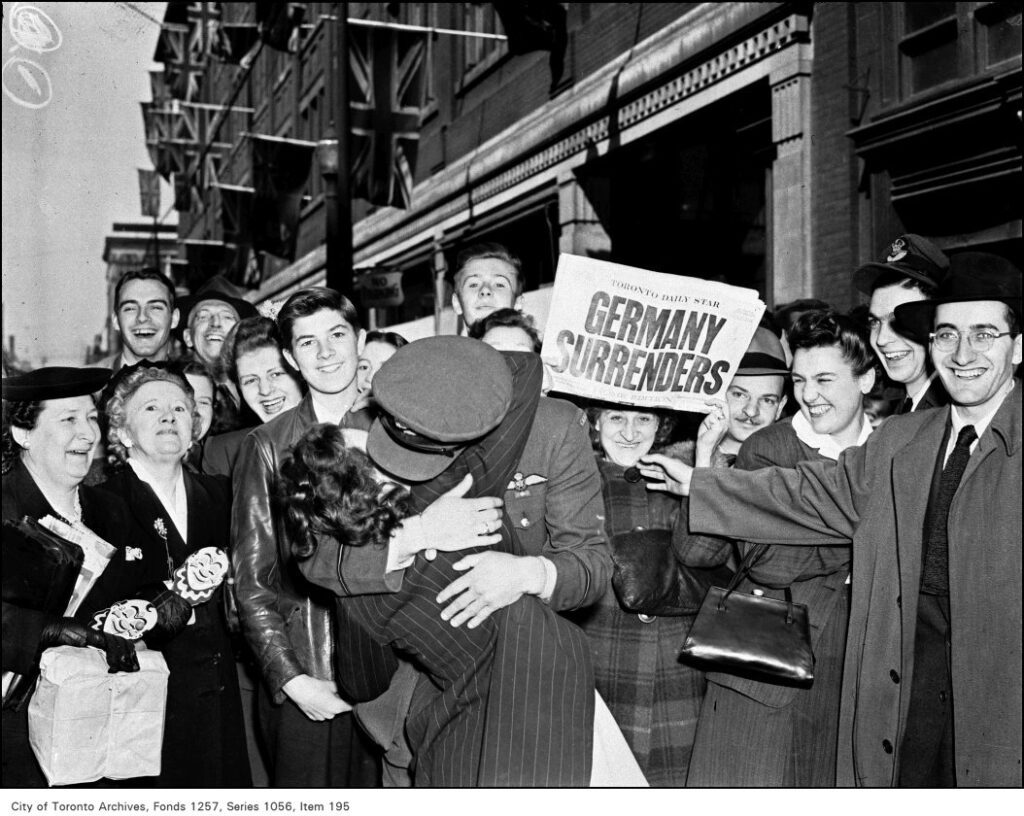
Source: City of Toronto Archives/Public domain.
In those last days of the war in Europe, the Nazis began to move their prisoners of war west away from the advancing Russians. Prison guards told Private James Molloy and his comrades, working the mines near Leipzig, to be ready to move. Given three days of bread rations, the Canadians began the long forced march. As Molloy wrote in his diary, “Well the first day is over and we are sitting in a huge barn with bags of straw to bed down on. We marched about 18 kilometers and it was slow… we still have a few tins of Red Cross [food]… .” Two days later, American tanks intercepted the POW column and the Germans fled or surrendered. After his long time in the salt mines, Molloy was free at last. Within a few days he arrived in England, and then soon after, returned home to Canada.
On May 8, 1945, bells rang out and cheers rose in celebration across Europe and back home in North America. After immense sacrifice and millions of casualties on all sides, the war in Europe had finally stumbled to a close. And while fighting continued to rage in the Pacific Theatre, total victory against the once-dreaded Axis powers finally seemed within reach.
About the author
Historian J.L. Granatstein is a member of the Macdonald-Laurier Institute’s Research Advisory Board. He taught history at the postsecondary level for 30 years. A bestselling author, Granatstein was the director and CEO of the Canadian War Museum. He writes on Canadian military history, foreign and defence policy, and politics. Among his publications are Canada’s War, The Generals, Canada’s Army, and Who Killed the Canadian Military? He is an officer in the Order of Canada.




